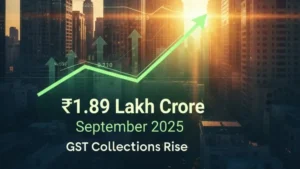India witnessed contrasting trends in its economic indicators in October and November, with the Index of Industrial Production (IIP) surging to a 16-month high while retail inflation experienced an uptick, reaching a three-month high. These developments have significant implications for GDP projections and monetary policy.
1. IIP Hits 16-Month High in October
- The IIP recorded an impressive 11.7% year-on-year growth in October, marking a substantial increase from the 6.8% reported in September.
- Key contributors to this growth were the electricity (20.4%), mining (13.1%), and manufacturing (10.4%) sectors, surpassing Bloomberg’s forecast of 10.5%.
2. Impact on GDP Estimates
- The robust performance of the IIP is expected to influence the first advance estimates of the gross domestic product (GDP) data for 2023-24, scheduled for release on January 5. This data will precede the Interim Budget for FY25, set to be presented on February 1.
3. Retail Inflation Rises in November
- Retail inflation, measured by the Consumer Price Index (CPI), increased to 5.55% year-on-year in November, up from 4.87% in October.
- The upward trajectory was attributed partly to a seasonal spike in vegetable prices, contributing to a three-month high in overall inflation.
4. Inflation Drivers
- Food inflation saw a notable rise, reaching 8.7% in November, with vegetable prices accelerating sharply by 17.7%.
- Other contributors to increased inflation included fruits (10.95%), pulses (20.23%), and sugar (6.55%).
5. Sector-wise Performance in IIP
- Among the 23 manufacturing industries, only four, including apparel, wood, computers, and furniture, witnessed contraction in October.
- Strong double-digit growth was observed in primary goods (11.4%), capital goods (22.6%), infrastructure goods (11.3%), and consumer durables (15.9%), indicating a revival in both urban and rural demand.
6. Core Inflation and Monetary Policy
- Core inflation, excluding volatile food and fuel components, stood close to 4% in November.
- The Monetary Policy Committee (MPC) of the Reserve Bank of India (RBI) unanimously kept the repo rate unchanged at 6.5% for the fifth consecutive policy review, with the central bank retaining its forecast for retail inflation at 5.4% for FY24.
Important Questions Related to Exams
Q: What was the growth rate of India’s Index of Industrial Production (IIP) in October?
A: The IIP surged to an 11.7% year-on-year growth in October.
Q: What sectors contributed significantly to the IIP growth?
A: Electricity (20.4%), mining (13.1%), and manufacturing (10.4%) sectors were key contributors.
Q: How did retail inflation perform in November?
A: Retail inflation rose to 5.55% in November, marking a three-month high.
Q: What were the drivers of the increased retail inflation?
A: Seasonal spikes in vegetable prices and upticks in fruits, pulses, and sugar contributed to the inflation rise.
Q: What impact did these economic indicators have on GDP estimates?
A: The robust IIP performance is expected to influence the first advance GDP estimates for 2023-24.
Q: What is the RBI’s stance on monetary policy and inflation forecasts?
A: The RBI maintained a 6.5% repo rate and retained a 5.4% retail inflation forecast for FY24.




 World Bank Ups India’s FY26 Growth Estim...
World Bank Ups India’s FY26 Growth Estim...
 Navratri 2025 Sales Hit Decade-High as G...
Navratri 2025 Sales Hit Decade-High as G...
 GST Collections Rise to ₹1.89 Lakh Crore...
GST Collections Rise to ₹1.89 Lakh Crore...

